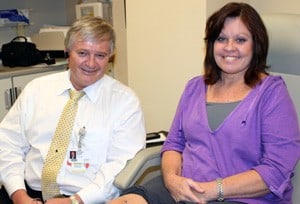Searcy Woman a Perfect Fit for First 30-Year Knee
| Before UAMS provided her the first 30-year knee implants in Arkansas, Martha Pearson had been nearly crippled by recurring knee problems since childhood.

UAMS Dr. Richard Evans told Martha Pearson she can expect her knee implants to be permanent.
She had nine knee surgeries from 1972 until 1990, when at age 31 there was no longer cartilage to repair. Without the cushion of cartilage, her knees were down to bone on bone. The only solution was knee replacement surgery, but she was forced to wait because of her age.
Knee implants have traditionally lasted 10-15 years, so knee surgeons have advised patients to make do until their late 60s or 70s. That’s because second knee replacements usually result in poor outcomes.
For Martha, now 51, the waiting was the hardest part. Despite the frequent, almost unbearable pain, she listened to doctors who encouraged her to hang in there because of continuing advancements in surgical techniques and materials used in the implants.
“I put off replacement surgery for as long as I could, but in these last three years it got to where I couldn’t really get around anymore,” said Martha, who has a 14-year-old daughter, Jessie. “I cant imagine what I would have done if I had to wait another 15 or 20 years.”
Over the last two decades, Martha endured valiantly doing all the things moms do, her husband, Bruce, said.
But this year, Martha felt she could wait no longer. On the advice of close family friend, Dr. B.J. Bailey, a fourth-year orthopedics resident at UAMS, she saw UAMS Dr. Richard Evans who is among a handful of elite knee and hip surgeons in the United States offering the latest, most advanced joint replacement materials and techniques.
Dr. Evans, chief of adult hip and knee reconstruction at UAMS, informed Martha that she was a good candidate for a knee joint that the federal Food and Drug Administration (FDA), had just certified would last 30 years. He performed the replacement surgeries on Sept. 16 and 17.
The 30-year FDA certification in July is the first time the FDA has stated the number of years consumers can expect a replacement joint to last.
“This is exciting news for anyone who may need knee replacement surgery, and that’s especially true for younger patients like Mrs. Pearson,” Dr. Evans said.
“Im pretty excited,” Martha said just two weeks after her surgery. “It’s just amazing to think that after all these years they won’t hurt anymore.”
The day after Thanksgiving Pearson shopped without pain for a full day. Prior to her surgery, a walk through the mall would have been agonizing, requiring several stops to rest. She also now takes the stairs without needing to put two feet on the same step as she goes up or down.
“I feel like 15 years have been just lifted off of me.”
“She’s had a stellar outcome,” Dr. Evans said. “She could be around another 50 years, and in the worst-case scenario she might need a minor operation to replace part of the knee, kind of like replacing brake pads on a car, not the whole system.”
Advances have occurred in all phases of knee replacement. The night before a surgery, Dr. Evans uses images of a patient’s knee to perform the surgery on a computer, ensuring that the new knee fits as it should and that everything goes as quickly and smoothly as possible in the operating room. Once in surgery, patients get an epidural rather than anesthesia that takes them completely under. The epidural enables the patient to get up and walk much more quickly, and it allows for the patients second knee replacement the following day.
“I think UAMS, with Dr. Evans, is the only place to have a knee replacement done,” Martha said.
Hip and Knee Surgery Center
Orthopedics
To learn more about the personalized care provided by our doctors using state-of-the-art equipment and technology, please visit our medical services section.
